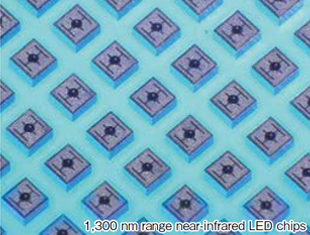Towards the Realization of Our Vision
●FY 2019 Plan
In FY 2019, while costs for such things as electricity and depreciation are rising, in addition to a rebound in purchasing conditions for smelting raw material, and the elimination of transient factors, we will promote initiatives to increase profits year-on-year via increased sales of existing and new products through the effect of measures in the Midterm Plan 2020.
With regards to forecasts for FY 2019 (ending March 2020), we are planning on sales increasing 27 billion yen year-on-year to 480 billion yen, operating profit increasing 5.8 billion yen year-on-year to 24.5 billion yen, ordinary profit increasing 5.6 billion yen year-on-year to 30 billion yen, and current net profit attributable to parent company shareholders increasing 5.0 billion yen year-on-year to 20 billion yen. Going forward, we will steadily carry out each measure and strengthen our business foundation for growth.

Development of near-infrared LED chips with global top-class output
DOWA ELECTRONICS MATERIALS CO., LTD.
In 2018, DOWA Electronics Materials succeeded in developing a near-infrared LED chip with global top-class output of 6.8mW*1, 3.5 times more than our exi sting product in the center wavelength 1,300 nm range.
Optical sensors using LEDs have excellent features such as sm all size, power-saving ability and long life, and are used in a variety of applications. The light source of optical sensors has a wide range of light wavelengths from infrared to visible light and ultraviolet light, and each has different properties. However, within this, since near infrared light wit h a wavelength range of 800 nm to 2,000 nm has the feature of high permeability for living organi sms, it is being advanced in the analysis of crops and food, and medical and healthcare applicat ions*2. Particularly in the healthcare field, where the market is expected to expand, by using LEDs in sensors, it is expected that the measurement of the blood glucose level could be realiz ed without the need for drawing blood.
The newly developed near-infrared LED chip with a center wavelength of 1,300 nm has significantly improved optical output in the direction of the upper surface, which is important as a sensor, while balancing the usual trade-off between high output and miniaturization.
DOWA Electronics Materials has already begun to provide samples, and they are preparing a development system that can flexibly meet various needs such as the customization of wavelength ranges. In the future these technologies will also be developed to the center wavelengths of the 1,450 nm and 1,650 nm range to expand our lineup.
- *1:350μm angular size, and an output value when direct current 100mA is applied at room temperature
- *2:Wavelength range and types of light & main applications



